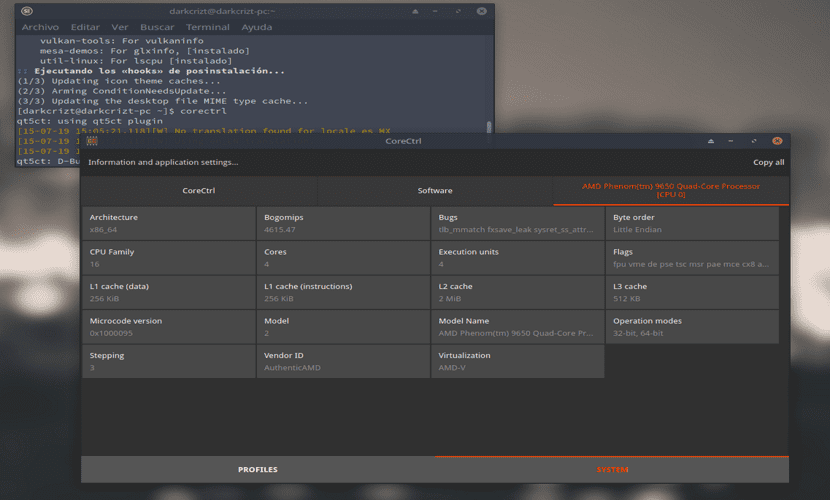
Few days ago the first version of CoreCtrl was released, which is a new app Linux that is designed to allow the user to easily control their computer hardware using application profiles.
The default settings are defined in a global profile. Also allows the user to create as many custom profiles as desired, each of them defining its own configuration. Each custom profile is associated with an executable program.
When the associated program starts, the profile settings will be applied automatically. Later, when the program ends, the previous settings are restored.
You can choose which elements of the system will be controlled by a profile, even for the global profile.
In this manner, some parts of the system will remain intact when the profile is applied. This will allow you to control those parts using other applications or define global behavior for one part while controlling other parts with custom profiles.
How to install CoreCtrl on Linux?
For those who are interested in being able to install this application in their distribution They can do so by following the instructions we share below.
CoreCtrl is an application that is just beginning to reach the main channels of Linux distributions, so it is possible to find it within the repositories of some of the Linux distributions.
They can search for the application with the help of their Software or Application Center or from the terminal using the search command from their package manager.
For distributions that have not yet been reached at this time (Debian, Ubuntu and derivatives, Fedora, openSUSE among derivatives of these) we will have to compile the application on our computers.
Before compiling we must carry out the previous installation of some dependencies which are:
- Qt components (5.9+): Core, DBus, Graphics, Widgets, Network
- Qt5LinguistTools
- KF5Auth
- Archive
- Bounce 2 (2.2.0+)
- C ++ 17 compiler (gcc 8 + 1, clang 7+)
- CMake 3.3 + 2
- extra-cmake-modules (for Ubuntu 18.04 LTS)
CoreCtrl compilation
For this let's open a terminal and download the CoreCtrl code with:
git clone https://gitlab.com/corectrl/corectrl.git
And we proceed to compile with:
cd corectrl mkdir build cd build cmake -DCMAKE_INSTALL_PREFIX=/usr -DCMAKE_BUILD_TYPE=Release -DBUILD_TESTING=OFF .. make
At the end we will install with:
sudo make install
CoreCtrl installation on Arch Linux and derivatives
In the case of those who are users of Arch Linux, Manjaro, Arco Linux and any other distribution derived from Arch Linux, they can install CoreCtrl directly from the AUR repositories.
They should only have an AUR wizard installed and the AUR repository enabled in their pacman.conf file
To install just open a terminal and in it we are going to type the following command:
yay -S corectrl
And with this we will only have to remove some packages that conflict with the corectrl dependencies (nothing serious) and will start with the download, compilation and installation (take your time)
CoreCtrl Settings
After you have successfully installed CoreCtrl we are going to open a terminal and on it we are going to execute the following command which will add CoreCtrl at the beginning of our user session:
cp /usr/share/applications/corectrl.desktop ~/.config/autostart/corectrl.desktop
With this, another additional step that can be done is to prevent the CoreCtrl wizard from asking for your password to run with root privileges. For this you will have to create a file with the following command:
sudo nano /etc/polkit-1/rules.d/90-corectrl.rules
And inside it you add the following:
polkit.addRule(function(action, subject) {
if ((action.id == "org.corectrl.helper.init" ||
action.id == "org.corectrl.helperkiller.init") &&
subject.local == true &&
subject.active == true &&
subject.isInGroup("your-user-group")) {
return polkit.Result.YES;
}
});
Finally to control AMD GPUs it is important to add a parameter to a grub line since CoreCtrl makes use of the amdgpu driver.
We just have to execute the following in a terminal:
sudo nano /etc/default/grub
Here we are going to look for the GRUB_CMDLINE_LINUX_DEFAULT line and in it we add:
GRUB_CMDLINE_LINUX_DEFAULT="<other_params>... amdgpu.ppfeaturemask=0xffffffff"
We save and then execute the following:
sudo grub-mkconfig -o /boot/grub/grub.cfg
Finally, if you want to know more about it, you can consult the following link where you can find documentation about CoreCtrl.